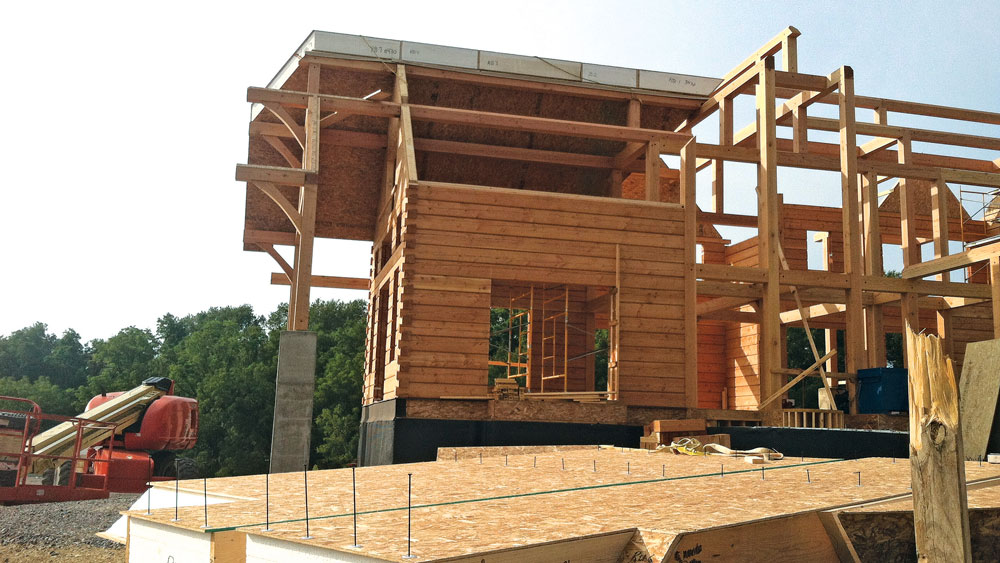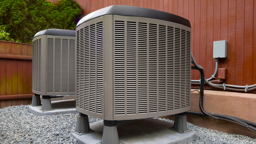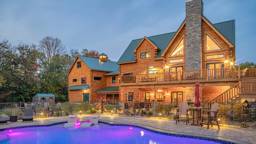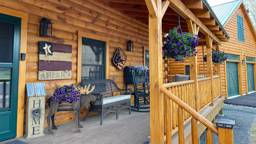
Of all the things your log home should be — sturdy, secluded, comfortably furnished — there’s one item that should never make the list: cold. First and foremost, your log home is a shelter built to save you from being ravaged by the elements. In a full-log home, your solid walls provide their own built-in protection, but your roof — and any conventionally framed areas your home may have — will require some reinforcements. Sure, you can turn to fiberglass batts or even spray foam, but we wanted to learn more about a third option, structural insulated panels, or SIPs. We sat down with Stephen Munn, general manager of Insulspan, a leading SIPs manufacturer, to learn how these super-insulated panels can enhance log home construction.
See also How Log Home Construction is Differrent From Conventional Building Methods
LHL: First and foremost, how do SIPs work?
SM: SIPs are created by laminating two pieces of performance-rated OSB2 (rated for structural applications) around a continuous core of EPS (expanded polystyrene) foam insulation. We can provide panel sizes as large as 8-by-24 feet, which allows us to cover a large area with one panel and reduces the number of studs needed for construction. This also reduces heat loss, thermal bridging and air leakage. The other key thing that we do with SIPs is we use a sealant at each of the joints, which diminishes the air flow. You can’t really do that with fiberglass batts or blown-in insulation.
How do SIPs compare with other types of insulation? What advantages do they have over the alternatives?
Batt insulation has an R-value of 8.8 but with SIPs we can get an effective R-value of around 22.6. A big factor in this is the amount of lumber that goes into creating the wall or roof. Because of the structural aspect of the SIPs, not as much lumber is required. Lumber doesn’t have the same thermal resistance as the SIPs.
In regard to spray foam insulation, one of the advantages is we can manufacture SIPs as thick as 12.25 inches, which offers an R-value up to 45. If you really want to increase the R-value, you can add another 20 percent by using a graphite-enhanced EPS foam. You can’t get a spray foam that’s that thick and provides that high of an R-value. The thing is, spray foam is created using a chemical reaction that will off-gas and break down over time, reducing the R-value. The EPS is a rigid, closed-cell foam made of plastic and air, which doesn’t degrade.
See also 9 Log Profile Options
For the layman, what is an R-value?
The R-value is the thermal resistance to the transfer of heat. It’s what’s used to measure the thermal resistance of a product. The higher the R-value, the greater the ability a material has to resist the transfer of heat in or out of the building.
How much energy can be saved by using SIPs over a conventional batt insulation?
The amount of energy saved would depend on the size of the building. With a 2-by-6 stud wall with R-20 batt insulation, the effective R-value is around 16.8, and with a 6.5-inch thick SIP we get an effective R-value of approximately 22.6. But it really depends on the size of the structure and the thickness of the walls or roof surfaces that you’re using.
SIPs are common in timber home construction; how do you use them in a log home? With log homes, they’re really efficient as a roof application. If you’re working with a log home that’s a hybrid, such as with log accents as opposed to genuine, full-log walls, SIPs mesh very well with that type of construction.
See also How Much Do Log Homes Cost?
How much do SIPs cost in relation to other products, especially in terms of ROI?
SIPs have a slightly higher initial-investment cost, but when you factor in the speed of construction and only needing to have one trade contractor as opposed to two (framing and insulation), buyers actually can save money during the installation process. The real savings, however, is what owners will see over the life of the home. With SIPs, the house requires a smaller HVAC unit because of the higher R-value and the reduced air flow, so equipment costs less. Then you’ll save even more on energy costs over time due to fewer air exchanges. These are the long-term savings.
What technological advances have been made in SIPs over the years?
The addition of the graphite enhanced EPS has enabled us to increase the R-value within all panel sizes. For ease of construction, we base our SIPs off standard lumber sizes; so, as an example, in a 6.5-inch wall, we can increase the R-value by 20 percent without increasing the thickness. Insulspan provides a comprehensive, ready-to-assemble package, where we install as much lumber as possible, so all the windows and doors are framed out ahead of time in the factory. When the panels arrive at the site, with the construction drawings we send, it’s literally taking part B and attaching it to part C and nailing them together, then you attach to part D… it really speeds up the construction process. We also have the electrical chases accounted for in the panels, making the wiring installation quick and easy.
Are SIPs something the average person could learn to install on their own? What sort of training would a do-it-yourselfer require?
We don’t just send out the panels and say, “Good luck!” We have installation guys that explain the process of how to install them. We also have InsulspanU. Once a quarter we bring people in for a one-day class to go through all the benefits of SIPs and then provide instruction on how to install them, including hands-on practice at the end.
There are laymen who install SIPs when they choose to. Most people don’t have the time or the inclination, but there are quite a few homeowners who do it themselves.










